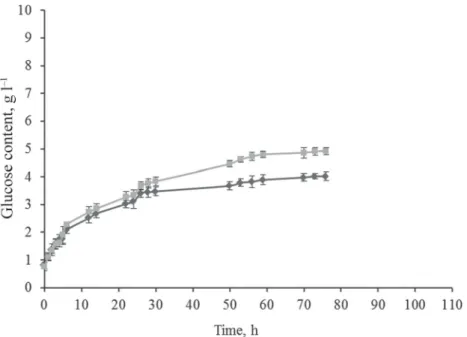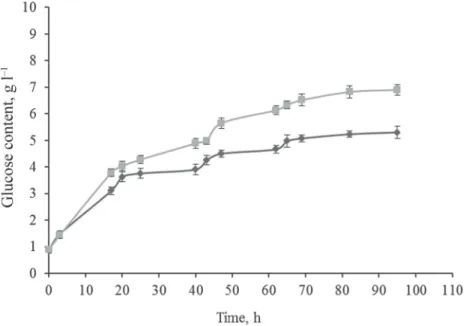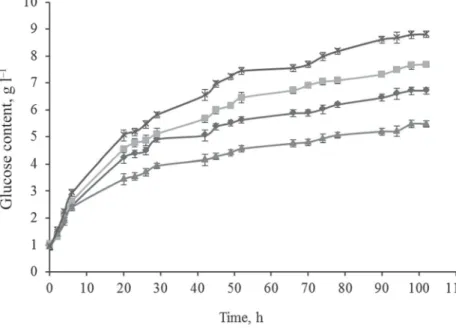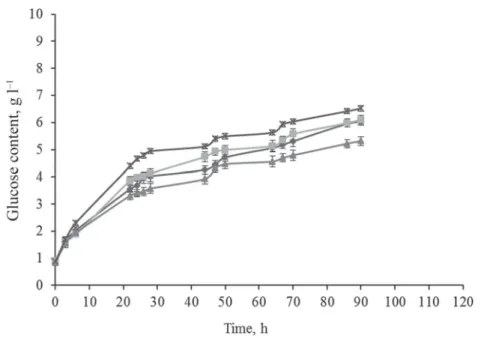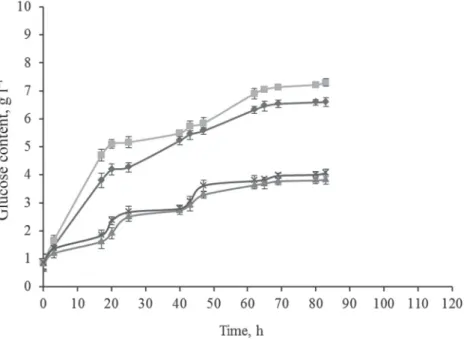DOI: 10.1556/066.2018.47.4.7
MICROWAVE STEAM EXPLOSION AND ENZYMATIC HYDROLYSIS OF VINE-BRANCH
V. KAPCSÁNDIa*, M. NEMÉNYIb and E. LAKATOSa aDepartment of Food Sciences
bDepartment of Biosystems and Food Engineering, Faculty of Agricultural and Food Sciences, Széchenyi István University, H-9200 Mosonmagyaróvár, Vár tér 2. Hungary
(Received: 1 February 2018; accepted: 14 July 2018)
Our research target was to utilise vine-branch, existing in huge amounts, for energetic purposes. During our experiments, microwave (MW) treatments of different powers (400–1600 W), pressures (1–5 bar), temperatures (120–180 °C), and treatment times (3–30 min) were applied to change the physical condition of vine-branch. After MW, enzymatic hydrolysis (EH) was used (85–100 h, 37 °C). In addition, beside MW, comparisons were made regarding various treatment methods: untreated (UTE), cooking plate (CP), and autoclave (AC), to determine to what extent they affect the fi nal glucose yield. This yield can even further be increased by MW pre-treatment (50 W, 3–30 min, 40 °C) of the enzyme used during the hydrolysis, which reinforces the argument that enzyme activity can be increased by irradiation. A difference of 22.1% was detected among the glucose yield values in untreated and treated enzyme processes.
Keywords: vine-branch, microwave, enzymatic hydrolysis
Biomass with lignocellulose content from agricultural production, as well as other agricultural wastes (KÁDÁR et al., 2004; CHERUBINI & STRØMMAN, 2011; BORRION et al., 2012), and plant biomass not suitable for nutrition purposes, e.g. grass, trees (BOLLÓK et al., 2000), and paper (LARK et al., 1997), are used for second generation biofuels.
The effects of lignocellulose pre-treatment have been known for many years (MCMILLAN, 1994). Various methods have been worked out for the digestion of cellulose (LEMMER et al., 2017), among them: hydrolysis with weak or strong acids (SUN & CHENG, 2005), with alkalis (HU & WEN, 2008); with wet oxidation (SCHMIDT & THOMSEN, 1998; PALONEN et al., 2004), pre-treatment with steam (VIOLA et al., 2008); enzymatic hydrolysis (DUFF & MURRAY, 1996), and various combinations of all the above (FENG et al., 2012, 2013). There are numerous studies dealing with microwave (MW) pre-treatment of cellulose-based biomass such as corn-stalk (DONEPUDI & MUTHUKUMARAPPAN, 2009), wheat-straw (SAHA et al., 2008), rice- straw (ZHU et al., 2005), soy-husk (KARUPPUCHAMY & MUTHUKUMARAPPAN, 2009), rice-husk (ZHAO et al., 2010), and panic-grass (HU & WEN, 2008; KESHWANI et al., 2007). SE, one of the most frequently used methods of pre-treatment (MCMILLAN, 1994), has proved to be an effective, quick, and cheap way of pre-treatment for enzymatic hydrolysis (JØRGENSEN et al., 2007; GNANSOUNOU, 2010).
Production cost of cellulase enzymes used for ethanol production from cellulose represents a very high portion. For cellulase production, fungi are in the focus of research.
The best extracellular cellulase producing microorganism is Trichoderma reesei for the
* To whom correspondence should be addressed.
Phone: +36 96 566-653; e-mail: kapcsandi.viktoria@sze.hu
hydrolysis of cellulose. This is a system of enzymes consisting of 60–80% cellobiohydrolase, 20–36% endoglucanase, and 1% β-glucosidase. These all contribute to the breaking down of cellulose to glucose (ZALDIVAR et al., 2001; MUTHUVELAYUDHAM & VIRUTHAGIRI, 2006).
1. Materials and methods
1.1. Raw material
Our raw material was the vine-branch remaining after pruning on one of the grape plantations of the Pannonhalma wine-region in Hungary. It was cut into pieces of 1–2 cm, applying manual force with the help of an averruncator, then split further into smaller particles of 0.1–1 mm with a grinder (Grinder Drive IKA MF10 Basic Microfi ne EU/AU).
The split vine-branch was treated with a Na-acetate – acetic acid buffer (pH 3.8). For the statistical evaluation, single factor analysis of variance and one-sample t-test were used.
1.2. Various treatments
During cellulose breakdown of vine-branch the following physical-chemical treatments were applied: microwave (MW) (400–1600 W, 1–5 bar, 120–180 °C, 3–30 min), autoclaving (AC) (120–135 °C; 1 bar, 3–30 min), cooking plate (CP) (100 °C, 15–30 min); then to all samples cellulase enzyme from Trichoderma reesei (Sigma-Aldrich, ATCC 26921) was added. The extent of cellulose degradation was followed by measuring the increase in glucose content with spectrophotometer (Hitachi U-2910, Double beam UV/VIS).
1.2.1. Enzymatic hydrolysis. An enzyme – 1,4-(1,3:1,4)-β-D-glucan-4-glucano- hydrolase of Sigma-Aldrich, ATCC 26921 – was added to the samples (20 g sample, 140 ml buffer, 2 ml enzyme), then the samples were incubated under continuous shaking at 37 °C.
Finally, the increase in glucose content was measured with a spectrophotometer (Hitachi U-2910, Double beam UV/VIS).
1.2.2. MW treatment. During MW, 20 g of the split vine-branch (10 g/vessel each) was placed into the Tefl on vessels of the MARS equipment used for MW processing, and then 70 ml of Na-acetate – acetic acid buffer solution was added. Because of the use of high pressure, the Tefl on vessels were covered with a kevlar jacket as supplied by the equipment manufacturer. The sample holders were placed into the MW equipment, and the sensors for temperature (RTP 300) and pressure (ESP+) control were inserted. In the control vessel, the built-in ESP+ pressure control device checks and controls the pressure developed during the reaction. Pressure measurement happens 200 times a sec.
During the treatment of the vine-branch, the sample holding vessels were only opened after the temperature of the samples decreased to 80 °C for safety reasons. The enzyme was added after the samples cooled down to 40 °C.
1.2.3. AC treatment. For the AC treatment the samples were also treated in a VAPOSTERI/P type AC under pressure. During these experiments, temperatures of 120–135
°C and pressure of 1 bar were applied, the treatment time varied. Into the vessels 20 g samples and 140 ml buffer solution were added. After the treatment, the samples were removed when the temperature in the AC decreased below 80 °C. After the samples cooled down to 40 °C,
2 ml enzyme Sigma-Aldrich, ATCC 26921 – was added. These samples were then incubated under continuous shaking at 37 °C. Finally, the increase in glucose content was measured with a spectrophotometer (Hitachi U-2910, Double beam UV/VIS).
1.2.4. CP treatment. For the CP treatment, 20 g of the split vine-branch was placed into Na-acetate buffer and onto the CP (Yellow Line, MST basic C), and treated for various periods at boiling point. After treatment the samples were cooled down, and the enzyme was added. Then the samples were incubated under continuous shaking (Yellow Line RS/OS 10 Basic, 160 r.p.m.) at 37 °C, similarly to the above process. Finally, the increase in glucose content was measured with a spectrophotometer.
1.2.5. Combinations of treatments. Treatments in various combinations were applied.
Treatment time, temperature, and pressure values were modifi ed. Beside the treatment of the vine-branch, in certain cases, the enzyme was MW treated (50 W, 40 °C, 3–30 min) as well.
Combinations were as follows: MW with added untreated enzyme (UTE); MW with added microwave treated enzyme (TE); AC treatment with added UTE; and CP treatment with added UTE.
2. Results and discussion
In the fi rst case: 5 min, 400 W, 120 °C and 1 bar (MW + UTE) and 5 min, 120 °C, 1 bar (AC + UTE) were applied. It can be seen from Figure 1, that there is no difference among the results of the two samples during the fi rst 5-hour period. After the 5th hour, as the result of the MW treatment, the intensity of cellulose decomposition increased compared to AC treatment.
From the results it can be seen that the difference increased up to 18.1%. On the basis of the statistical analysis, there is a signifi cant difference between the samples (P=95%).
Fig. 1. Enzymatic breakdown of vine-branch treated in AC ( ) and through MW ( )
In the next experiment vine-branch was MW treated for 15 min, 400 W, 120 °C, 1 bar;
and the enzyme for 15 min, 50 W, 40 °C. From the results it can be seen that a higher increase in glucose content was achieved for MW treated vine-branch with treated cellulose enzyme (Fig. 2). The difference between treatments reached 22.1% at the end of the measurements.
There was also a signifi cant difference at 98% probability level between the samples.
Fig. 2. Enzymatic treatment of vine-branch for MW + UTE ( ), and MW + TE ( )
Other treatment combinations for vine-branch were as follows: AC (430 W, 120 °C, 1 bar); MW (1600 W, 120 °C, 1 bar), and CP (100 °C); in the case of all samples, treatment time was 15 min (Fig. 3A). Microwave irradiation of the enzyme was also done for 15 min.
Based on the results it can be stated that the lowest glucose values were achieved with CP treatment. The difference was in this case 38.9% compared to the sample MW + TE; 29.7%
to MW + UTE; and 18.5% to AC. The second place was given to vine-branch treated in AC.
The differences between AC and MW + UTE or MW + TE were 12.6% and 23.8%, respectively. The best results were obtained with the two samples treated with MW with or without enzyme microwave irradiation. The difference between the two MW treatments was 12.8%. This difference proves that a pre-treatment of the enzyme with low energy increases its activity. The results defi nitely show that MW affects enzyme activity and cellulose decomposition ability of the enzyme.
In comparison to the aforementioned treatments (Fig. 3A), the MW power level was changed for the next series of experiments. As the AC works at 430 W, our MW equipment was set to that power as well, the other parameters remained unchanged, as during the previous measurements (Fig. 3B).
Fig. 3A. Enzymatic breakdown process of vine-branch with different treatments:
CP + UTE ( ); AC + UTE ( ); MW + UTE ( ); MW + TE ( )
Fig. 3B. Enzymatic breakdown process of vine-branch with different treatments at the power level of 440 W:
CP + UTE ( ); AC + UTE ( ); microwave + UTE ( ); microwave + TE ( )
Only the results from the CP samples were lower than those of the other treatments. The difference between “AC + UTE” and “MW + UTE” was 9.26%. However, here the difference between the two MW treatments decreased to 5.7%. It can be stated that the best results were obtained in the cases of MW TEs. It can be deducted that the enzyme activity is increased by MW treatment.
In the next measurement series, samples were measured under the same treatment parameters, only with application of different treatment times. In Fig. 4, a treatment time of 30 min was used. With increasing treatment time, the cellulose decomposition ability of the enzyme is becoming more and more uniform among the samples of different treatments. The greatest difference was also between the samples with CP treatment and MW treatments, the difference values were 12.8% and 18.7%, respectively. The differences between the samples AC, MW + UTE, and AC, MW + TE, however, decreased to 1.5% and 7.2%, respectively.
This can probably be explained by the fact that the treatment of the vine-branch for a longer time, even in AC, gives the enzyme a better accessibility to the cellulose after a certain time.
Fig. 4. Enzymatic decomposition of four vine-branches with different treatments at 30 min treatment time:
CP + UTE ( ); AC + UTE ( ); microwave + UTE ( ); microwave + TE ( )
After the experimental results from 1 bar MW treatments, comparisons were made for samples with 2 bar and 5 bar treatments (1600 W, 150 °C, 10 min) (Fig. 5A). In this case the MW treatment of the enzyme was 3 min. Between the results from the samples treated at the same pressures, in the case of 2 bar treatment, there was a difference of 4.5% between the MW UTE and MW TE treatments, and for the 5 bar treatment, the difference was 15.8%.
When comparing the treatments at these 2 pressure values, the difference for samples with UTE was 16.5%, and that with TE was 26.4%.
Using the measurement parameters of the previous series with 2 bar and 5 bar pressures, the temperature was changed to 180 °C, and the enzyme treatment time to 10 min (Fig. 5B).
From the results it can be seen that in the case of 2 bar treatments, there is nearly no difference, only 2.9%, among the results of the samples. In the case of 5 bar treatments, there was a difference of 12.4% among the results. Here it can also be clearly seen that a MW pre- treatment of the enzyme positively affects its activity.
Fig. 5A. Results of samples treated at 150 °C; 2 bar MW + UTE ( ); 2 bar MW + TE ( );
5 bar MW + UTE ( ); and 5 bar MW + TE (3 min, 50 W, 40 °C) ( )
Fig. 5B. Results of samples treated at 180 °C; 2 bar MW + UTE ( ); 2 bar MW + TE ( );
5 bar MW + UTE ( ); and 5 bar MW + TE (10 min, 50 W, 40 °C) ( )
In the last experiment the following parameters were used: 800 W, 1 bar and 2 bar, 180
°C, and treatment time 10 min. The results among the samples treated at 1 bar (Fig. 6) show a difference of 4%, while in the case of treatments with 1600 W power, the difference was 2.9%. Among the cellulose decomposition results obtained from 2 bar treatments, there was a difference of 8.5%, while in the case of treatments with 1600 W power, the treatment resulted in 4.5% difference. In treatments with UTEs, the difference was 42.4%, while with TEs, this difference was 44.5%. On the basis of these results it can be stated that better results regarding cellulose decomposition were obtained with pre-treated samples at 800 W in comparison to 1600 W treatments.
Fig. 6. Glucose yields of vine-branches at 180 °C; 1 bar ( ) and 2 bar MW + UTE ( );
1 bar ( ) and 2 bar ( ) MW + TE
HU and WEN (2008) subjected millet samples to microwave pre-treatment (1000 W, 30 min, 190 °C), which resulted in 53% higher fi nal sugar concentration compared to the conventional heat treatment. This provided a maximum of 37.8% increase in our case.
MA and co-workers (2009) have also demonstrated that microwaves were an effective pre-treatment process, as it was able to increase the digestibility of rice straw at 680 W, 24 min by 30.3–43.3%. This is in agreement with our results, as the difference between the samples treated with microwaves was 12.6–23.2%.
Our results are in agreement with the results of ZHU and co-workers (2006), who found that microwave treatment of enzyme suspension (300 W, 15 sec) increased its activity. In our case a 9.26–22.1% increase was achieved with enzyme treatment (50 W, 40 °C, 3–30 min).
3. Conclusions
On the basis of the results it can be stated that signifi cant differences may be achieved in glucose yield by varying treatment time, microwave power, and temperature. Through the changes of these parameters the effi ciency of the hydrolysis was infl uenced. Yield can be even further increased by applying microwave pre-treatment to the enzyme used in the hydrolysis process, which reinforces the fact that enzyme activity can be increased by irradiation. During the experiments with untreated and pre-treated enzymes, a minimum difference of 1.5% and a maximum difference of 22.1% was obtained.
*
The publication was supported by the EFOP-3.6.3-VEKOP-16-2017-00008 project. The project is co-fi nanced by the European Union and the European Social Fund.
References
BOLLÓK, M., RÉCZEY, K. & ZACCHI, G. (2000): Simultaneous saccharifi cation and fermentation of steam-pretreated spruce to ethanol. Appl. Biochem. Biotech., 84, 69–80.
BORRION, A.L., MCMANUS, M.C. & HAMMOND, G.P. (2012): Environmental life cycle assessment of lignocellulosic conversion to ethanol: A review. Renew. Sust. Energ. Rev., 16, 4638–4650.
CHERUBINI, F. & STRØMMAN, A.H. (2011): Life cycle assessment of bioenergy systems: State of the art and future challenges. Bioresource Technol., 102, 437–451.
DONEPUDI, A. & MUTHUKUMARAPPAN, K. (2009): Effect of microwave pretreatment on sugar recovery from corn stover. ASABE International Conference, Reno, Nevada, June 21–24, doi:10.13031/2013.27442, paper no.
097057.
DUFF, S. & MURRAY, W. (1996): Bioconversion of forest products industry waste cellulosics to fuel ethanol: A review.
Bioresource Technol., 55, 1–33.
FENG, P., SHULIN, X., SHENGSHUAN, Y., CHAO, Z., BING, L. & YONG, K. (2012): Effects of MW power and MW irradiation time on pretreatment effi ciency and characteristics of corn stover using combination of SE and MW irradiation (SE-MI) pretreatment. Bioresource Technol., 118, 111–119.
FENG, P., SHULIN, X., SHENGSHUAN, Y., CHAO, Z., BING, L. & YONG, K. (2013): Effects of combination of SE and MW irradiation (SE-MI) pretreatment on enzymatic hydrolysis, sugar yield and structural properties of corn stover.
Ind. Crop. Prod., 42, 402–408.
GNANSOUNOU, E. (2010): Production and use of lignocellulosic bioethanol in Europe: Current situation and perspectives. Bioresource Technol., 101, 4842–4850.
HU, Z. & WEN, Z. (2008): Enhancing enzymatic digestibility of switchgrass by MW-assisted alkali pretreatment.
Biochem. Eng. J., 38, 369–378.
JØRGENSEN, H., KRISTENSEN, J.B. & FELBY, C. (2007): Enzymatic conversion of lignocellulose into fermentable sugars: Challenges and opportunities. Biofuel. Bioprod. Bior., 1, 119–134.
KÁDÁR, ZS., SZENGYEL, ZS. & RÉCZEY, K. (2004): Simultaneous saccharifi cation and fermentation (SSF) of industrial wastes for the production of ethanol. Ind. Crop. Prod., 20, 103–110.
KARUPPUCHAMY, V. & MUTHUKUMARAPPAN, K. (2009): Enzymatic hydrolysis of MW pretreated soy hull. ASABE/
CSBE 2009 North Central Intersectional Meeting. ASABE paper no. SD09-401.
KESHWANI, D.R., CHENG, J.J., BURNS, J.C., LI, L. & CHIANG, V. (2007): Microwave pretreatment of switchgrass to enhance enzymatic hydrolysis. ASABE International Conference. St. Joseph, MI, ASABE paper no. 077127.
LARK, N., XIA, Y., QIN, C.G., GONG, C.S. & TSAO, G.T. (1997): Production of ethanol from recycled paper sludge using cellulase and yeast, Kluyveromyces marxianus. Biomass Bioenerg., 12, 135–143.
LEMMER, B., JÁKÓI, Z., BESZÉDES, S., KESZTHELYI-SZABÓ, G. & HODÚR, C. (2017): Microwave enhanced enzymatic hydrolysis of corncob residues. -in: MAGÓ, L., KURJÁK, Z. & SZABÓ, I. (Eds) SYNERGY - Engineering, Agriculture and Green Industry Innovation. Gödöllő, Hungary, 16–19 October 2017. p. 91.
MA, H., LIU, W., CHENC, X., WUA, Y. & YUA, Z. (2009): Enhanced enzymatic saccharifi cation of rice straw by microwave pretreatment. Bioresource Technol., 100(3), 1279–1284.
MCMILLAN, J.D. (1994): Pretreatment of lignocellulosic biomass. -in: HIMMEL, M.E., BAKER, J.O. & OVEREND, R.P.
(Eds) Enzymatic conversion of biomass for fuels production. Am. Chem. Soc., Washington, DC, pp. 292–324.
MUTHUVELAYUDHAM, R. & VIRUTHAGIRI, T. (2006): Fermentative production and kinetics of cellulose protein on Trichoderma reesei using sugar cane bagasse and rice straw. Afr. J. Biotechnol. 5, 1873–1881.
PALONEN, H., THOMSEN, A.B., TENKANEN, M., SCHMIDT, A.S. & VIIKARI, L. (2004): Evaluation of wet oxidation pretreatment for enzymatic hydrolysis of softwood. Appl. Biochem. Biotech., 117, 1–17.
SAHA, B.C., BISWAS, A. & COTTA, M.A. (2008): MW pretreatment, enzymatic saccharifi cation and fermentation of wheat straw to ethanol. J. Biobased Mater. Bio., 2(3), 210–217.
SCHMIDT, A.S. & THOMSEN, A.B. (1998): Optimization of wet oxidation pretreatment of wheat straw. Bioresource Technol., 64, 139–151.
SUN, Y. & CHENG, J.J. (2005): Dilute acid pretreatment of rye straw and bermudagrass for ethanol production.
Bioresource Technol., 96, 1599–1606.
VIOLA, E., CARDINALE, M., SANTARCANGELO, R., VILLONE, A. & ZIMBARDI, F. (2008): Ethanol from eel grass via SE and enzymatic hydrolysis. Biomass. Bioenerg., 32, 613–618.
ZALDIVAR. M., VELASQUEZ, J.C., CONTRERAS, I. & PEREZ, L.M. (2001): Trichoderma aureoviride 7-121, a mutant with enhanced production of lytic enzymes: Its potential use in waste cellulose degradation and/or biocontrol.
Electron. J. Biotechn., 4(3), 1–7.
ZHAO, X., ZHOU, Y., ZHENG, G. & LIU, D. (2010): Microwave pretreatment of substrates for cellulase production by solid-state fermentation. Appl. Biochem. Biotechnol., 160, 1557–1571.
ZHU, S.D., YU, Z.N., WU, Y.X., ZHANG, X., LI, H. & GAO, M. (2005): Enhancing enzymatic hydrolysis of rice straw by microwave pretreatment. Chem. Eng. Commun., 192(12), 1559–1566.
ZHU, S., WU, Y., YU, Z., ZHANG, X., LI, H. & GAO, M. (2006): The effect of microwave irradiation on enzymatic hydrolysis of rice straw. Bioresource Technol., 97, 1964–1968.
